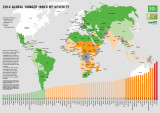Assessing the long-term impact of microcredit on rural poverty
In recent years, microfinance institutions are seen as beacons of hope to help eradicate poverty through, among others, providing credit to poor rural households. Availability of small but repeated loans is, in the long-term, expected to impact on poverty. However, decades after the introduction of microfinance institutions into many rural areas, there are still questions as to what extent such long-term benefits are realized.










